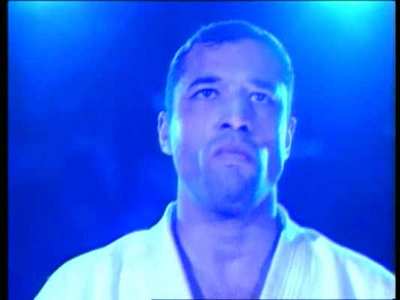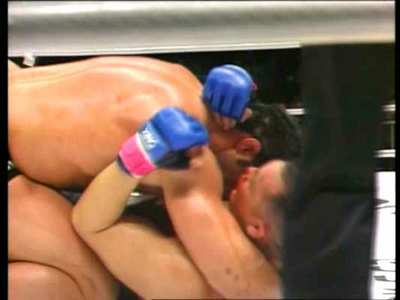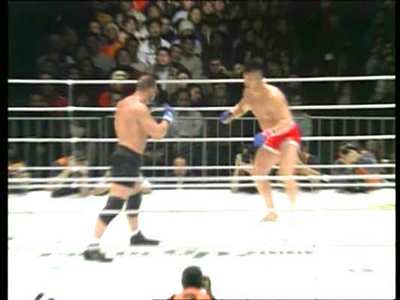Review of Pride FC: Grand Prix 2000 (3 Discs)
Introduction
PRIDE Fighting Championships` "Grand Prix Finals 2000" was a spectacular event, for many reasons. Although significant, it wasn`t the fact that the show was held at the famous Tokyo Dome in Japan, or that 38,000 people attended the event. Nor was it spectacular because Ken Shamrock fought an MMA match for the first time in four years.
Royce Gracie vs. Kazushi Sakuraba is the reason why the event is still talked about in glorified terms today.
Gracie was a former 3-time UFC tournament champion, who had never been beaten. Sakuraba was one of the golden boys of Japanese MMA, having had impressive wins over the likes of Vernon White, Carlos Newton, and Vitor Belfort. The anticipation for Gracie vs. Sakuraba was therefore huge, with the Japanese fans desperate to see their countryman topple the "unbeatable" Gracie. They willed Sakuraba on more when it was discovered that Gracie had used all his influence to change PRIDE`s rules for the bout, so that there would be no time limits and no referee stoppages.
So when Sakuraba toppled Gracie, he not only became a true superstar, but PRIDE became a symbol of glory for Japan. The bout had lasted a staggering ninety minutes, and only ended when Gracie`s corner threw in the towel.
PRIDE, the company, would never quite be the same again. From there, attendance figures were consistently staggering (often at what would become PRIDE`s home, the Saitama Super Arena), and new records were set for Japanese pay-per-view. At the company`s peak in 2003, they had developed the sport to the point where on New Year`s Eve, two other companies ran MMA shows in an attempt to compete with them, and all three shows aired live on Japanese television.
This three-disc DVD set, then, captures a majorly-historic event in MMA history. As well as the Grand Prix Finals, also included is the Opening Round of the tournament, which saw Sakuraba face Guy Mezger, and Gracie duel with pro wrestling legend, Nobuhiko Takada.
The Grand Prix Opening Round was held on 30th January 2000, with the Finals on 1st May 2000. Both events were held at the Tokyo Dome in Tokyo, Japan.

Video
Video is presented in 4:3 fullscreen PAL, and overall, is good for a DVD of this genre. If there is one main complaint, it is that the image is rather soft, which is partially down to its NTSC origins. Also, the arena is lit a little more darkly than we have come to expect from more recent PRIDE shows. Neither of these issues, however, affect your enjoyment of the event.
The transfer to DVD is very good indeed, especially considering how much footage has been squeezed onto each disc, and no compression artefacts are noticeable at any time.

Audio
Audio is presented in Dolby Digital 2.0, and is reasonable for a DVD of this genre.
Although the Grand Prix Finals was the first PRIDE show to be seen on American pay-per-view, I believe that the commentary by Stephen Quadros and Bas Rutten has been overdubbed - in other words, they did not commentate live at the event. This takes away somewhat from the show`s live feel, which is a crucial blow to the quality of the commentary, and also creates problems when the reserved Japanese crowd actually begins to make some noise.
Furthermore, neither man appears particularly comfortable with his role in the commentary, as Quadros is not his usual informative, wordsmith-like self, and Rutten displays almost none of the charisma which has been so important to the commentary of other PRIDE events.
From a technical standpoint, the audio is quite good, with all in-ring action easily audible, including at times, the voices of the competitors` corners.

Features
There are some nice, brief extras available here on Disc Three, their brevity not surprising given the amount of footage that is available across the set.
First is the ten minute "What is PRIDE?" feature, that has been on several previous releases, but remains a must for anyone who is watching the company for the first time. There is then an eleven-minute music video, showing the fighters` preparations for their bouts.
The pre-fight interviews are of some interest, although everyone, even Ken Shamrock, seems a little subdued. An event photo gallery provides some nice captures of the event, and the fighter biographies, although not particularly detailed, will at least add a little colour to each of the fighters` personalities.
To close, there are text details of the rules of PRIDE, and a glossary of fight terms. Also included is a look at the program covers from both the Opening Round and the Finals events.

Conclusion
Unlike my previous MMA reviews, I won`t go into detail about each individual match, so as to not give away spoilers regarding the tournament`s outcome. Before you ask, I realise that I have already spoiled at least one match by stating that Sakuraba and Gracie met in the quarter-finals, but the significance of that match is so great that to not make mention of it would undermine this review.
Indeed, it is the historical legacy that is the selling point of the Grand Prix 2000, because I can assure you, the event bouts cannot hold a candle to MMA as we know it today. Of the eighteen bouts available here, there are five atrocious contests, and several others which leave a lot to be desired. Other the course of the two events, the best bout is probably the non-tournament match in which Ken Shamrock faces Alexander Otsuka, but it is leagues away from the high standard we have come to expect in 2007.
In itself, the Sakuraba vs. Gracie bout is a bone of contention among fight fans. Some see it as a boring, inactive encounter, which is impossible to keep patience with. Others argue that the story of the bout, and its historical significance, make it a must-watch, and a keepsake of a great period for MMA in Japan. As usual, the truth lies somewhere in between, as it is sorely tempting to fast-forward much of the bout - the stalled nature of which is almost all down to the tactics of Gracie - but the knowledge that this is a historic bout for MMA makes it quite compelling.
Speaking of Sakuraba vs. Gracie, there is an odd editing occurrence at the beginning of Disc Two, as the match order has been switched around, meaning that here, Sakuraba vs. Gracie occurs before Igor Vovchanchyn vs. Gary Goodridge. I don`t know why this is the case, but it is a dreadful error, as commentator Quadros refers to the winner of Vovchanchyn/Goodridge contest before we have even seen it.
In any case, if it were not for the historical significance of this event, I would be highly recommending that you avoid this title, almost at all costs. However, if you have an interest in such matters, Grand Prix 2000 is an absolute must-see. If you care little for the story of the event, though, and are interested only in quality fight action, be sure to check out a more recent PRIDE offering instead.
Your Opinions and Comments
Be the first to post a comment!